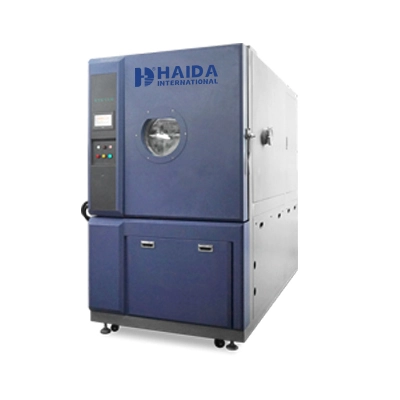Haida test equipment obtained certificate of new high-tech enterprise in 2019 Phone:+86-13602361535 E-mail:manager@qc-test.com

Battery Altitude Chamber
Battery Altitude Chamber
APPLICATION
Battery altitude chamber is used to simulate test environments at different altitude, nd can be customized according to test requirements. This is especially important for defense and aerospace applications where pressure and vacuum conditions are worse,
such as aviation, aerospace, communications, electronics and electrical applicances. The test objective is to ensure the maximum possible quality and reliablity of the product or material at different heights.
STANDARD SPECIFICATIONS
Vacuum pressure | 1 ~ 100Kpa |
Vacuum control | Touch Screen Controller |
Vacuum unit switch | Kpa/Mpa |
Temperature range | RT ~ 0℃ |
Pumping rate | Rise rate 305m per 30-60s until setting pressure is achieved. |
Pressure holding time | 0~999h/m/s |
Inner size | 400X500X500mm (100L) |
Internal material | SUS# 304 Stainless Steel |
External material | Steel plate with paint coating |
Power | Single phase, 220V/50HZ |
Test condition | ASTM D4169 Schedule I, ASTM D6653 |
ASTM D6653 TEST PROCEDURE
Step 1: Select your vacuum chamber which capable of appropriately withstanding 1 atm pressure differential across the walls. The vacuum gauge must be sealed to the chamber and capable of a vacuum range from 0 to 100 kPa.
Step 2: Determine your sampling method which should be representative of your sample to permit adequate determination of performance. If you cannot determine a good sample size, at least 3 representative samples must be selected for performance evaluation.
Step 3: Test specimen must be conditioned to 5.6 +/- 2 Degrees Celsius for 24 hours prior to testing. Test specimens must also be tested at 5.6 +/- 2 Degrees Celsius.
Step 4: Place the Test Specimen into the Vacuum Chamber and turn the vacuum source by making the vacuum rise by 1000 ft or 305 m for every 30 to 60 seconds until the appropriate pressure/vacuum is achieved.
Step 5: Attain a pressure equivalent of 4,877 m +/- 5%; this correspond to an absolute pressure of 56.3 kPa, or 16.22 in Hg. An elevation of 4,267m may be aimed for if 4,877 m is not achievable or inappropriate; this corresponds to an absolute pressure of 59.5 kPa.
Step 6: Maintain the achieved vacuum for 60 minutes.
Step 7: After the 60 min vacuum hold time has elapsed, release the vacuum at a rate of 1000 ft or 305 m for every 30 ~ 60 seconds.
Step 8: Once vacuum has been released, open the chamber, and examine your specimen for damage or deformation.
Leave A Message
HAIDA Test Equipment
Contact us
Contact: Mrs. Zhong
WeChat: haida13602361535
E-mail: manager@qc-test.com
Phone: +86-13602361535
Add: Room 101, Building 3, No. 1, Dongwei 1st Road, Wanjiang Street, Dongguan City, Guangdong Province, China


